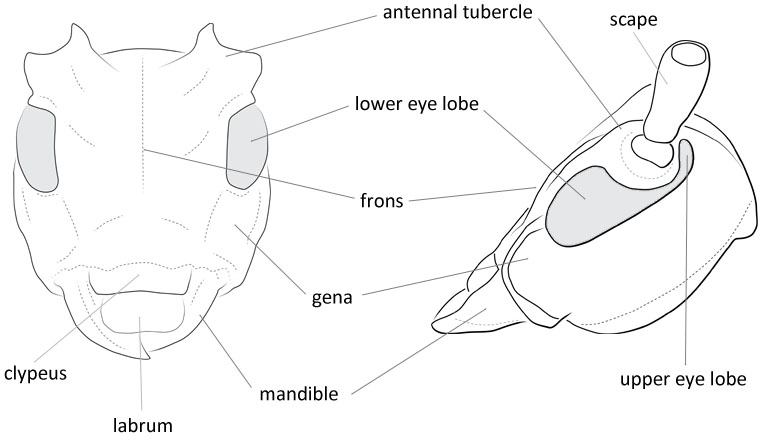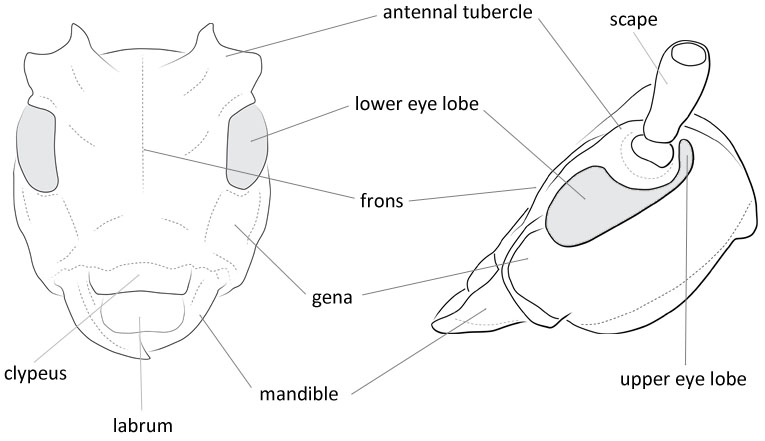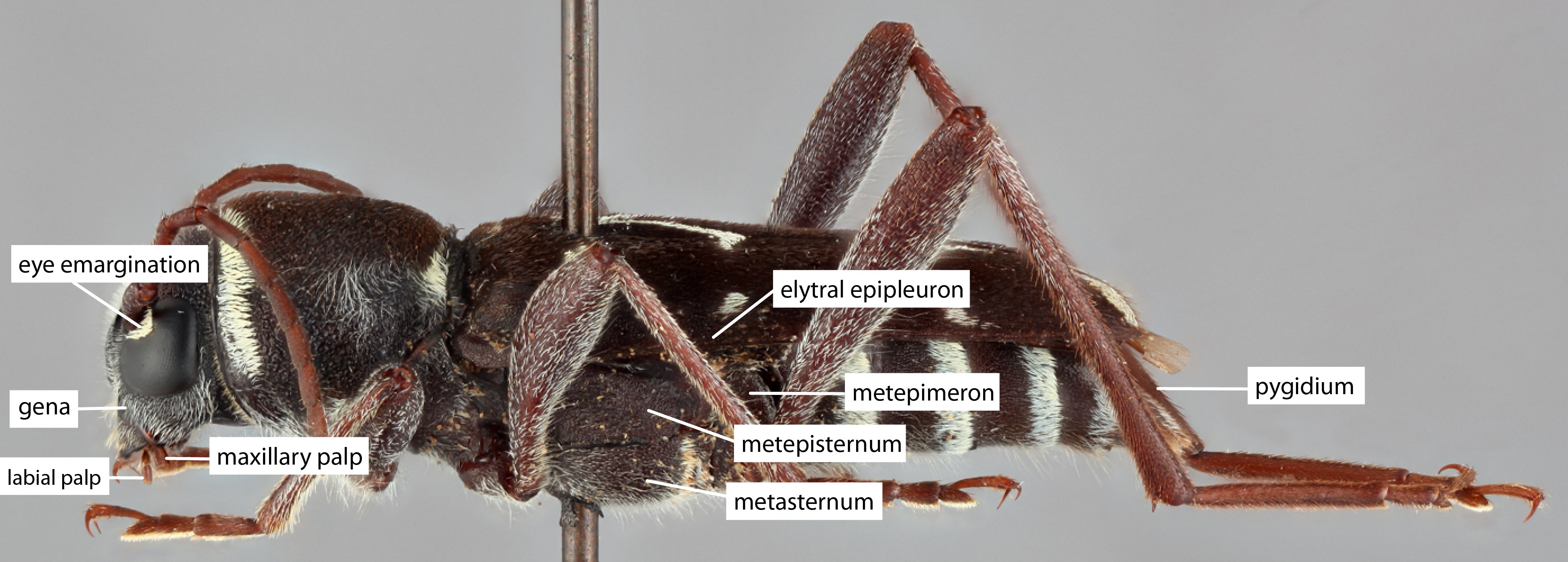Monohammus impluviatus Motschulsky, 1859: 571
Length: 11–18 mm.
Elytral length:width ratio: length > 2x width or length < 2x width.
Face: shape wide rectangle; genagena:
the part of the cranium on each side below the eye length longer than lower eye lobeeye lobe:
length longer than lower eye lobeeye lobe:
used to refer to the upper or lower portion when the eye is emarginate or separated or subequal to lower eye lobeeye lobe:
or subequal to lower eye lobeeye lobe:
used to refer to the upper or lower portion when the eye is emarginate or separated .
.
Pronotum: dense setaeseta:
a sclerotized hair-like projection of the cuticle
on dorsum of lateral spines absent; maculaemacula:
a spot or mark
on pronotal disk: 2–4 dots present; posteromedial tubercletubercle:
a small knoblike or rounded protuberance
absent; lateral erect setaeseta:
a sclerotized hair-like projection of the cuticle
: only present posterior to spinespine:
a protuberance with an acute (sharp) distal end
.
Scutellum: pubescence broken at least partially along midline.
Elytra: elytral integument color black; elytral maculaemacula:
a spot or mark
: many small circular spots or sparse ash-like pubescence; elytral sutural apexapex:
end of any structure distad to the base
rounded; elevation in basal third followed by impression absent; basal granulation dense and smooth; middle to apical punctationpunctation:
pits or depression of variable size in cuticle
fine.
Antennal length (female): 0–1 segment beyond elytral apexapex:
end of any structure distad to the base
.
Aedeagus: paramereparamere:
A pair of finger-like structures that are located where the male genitalia exits the abdomen.
mediobasal tooth present; apical tip (ventral view) slightly rounded or weakly bifidbifid:
cleft or divided into two parts; forked
; terminal segment absent; scleritesclerite:
any hardened plate of the body wall bounded by membrane or sutures; sometimes found floating in the internal sac of male genitalia
in internal sac: contains a scleritesclerite:
any hardened plate of the body wall bounded by membrane or sutures; sometimes found floating in the internal sac of male genitalia
in internal sac.
Distinguished from other species of the genus by short thick body, sharp granular punctationpunctation:
pits or depression of variable size in cuticle
at basebase:
the part of any appendage or structure that is nearest the body
of elytraelytron:
the leathery forewing of beetles, serving as a covering for the hind wings, commonly meeting opposite elytron in a straight line down the middle of the dorsum in repose
, and minute grayish pilose specks on elytraelytron:
the leathery forewing of beetles, serving as a covering for the hind wings, commonly meeting opposite elytron in a straight line down the middle of the dorsum in repose
. Head on occiputocciput:
dorsal part of the head between the occipital sulcus and the postoccipital sulcus
broadly rounded, with bold punctationpunctation:
pits or depression of variable size in cuticle
, sinciput depressed, here with round yellow spot, fronsfrons:
the upper anterior portion of the head capsule, usually a distinct sclerite between the epicranium and clypeus barely convex, with minute evanescent punctationpunctation:
barely convex, with minute evanescent punctationpunctation:
pits or depression of variable size in cuticle
and gray adherent, not very dense hairs, medially with narrow longitudinal groove, near basebase:
the part of any appendage or structure that is nearest the body
of antennaeantenna:
in larval and adult insects, paired segmented appendages, borne one on each side of the head, functioning as sense organs and bearing a large number of sensilla
with more (male) or less (female) produced tubercletubercle:
a small knoblike or rounded protuberance
. Eyes broadly emarginateemarginate:
notched at the margin , sharply faceted. AntennaeAntenna:
, sharply faceted. AntennaeAntenna:
in larval and adult insects, paired segmented appendages, borne one on each side of the head, functioning as sense organs and bearing a large number of sensilla
thick, short, in females extending or even not extending up to apexapex:
end of any structure distad to the base
of elytraelytron:
the leathery forewing of beetles, serving as a covering for the hind wings, commonly meeting opposite elytron in a straight line down the middle of the dorsum in repose
, in males extending beyond by 8th segment; segments basally with gray pilose ringlets (female) or without them (male). Pronotumpronotum:
the upper and dorsal part of the prothorax
transverse, laterally with conicalconical:
wider at base than apex
spiniformly extended tubercletubercle:
a small knoblike or rounded protuberance
, apically and basally with broad flange, disk convex, with bold uneven, sometimes transversely rugoserugose:
wrinkled
punctationpunctation:
pits or depression of variable size in cuticle
and somewhat rusty or grayish, randomly distributed adherent hairs forming behind anterior flange four small round spotlets—two on disk and one on each side at basebase:
the part of any appendage or structure that is nearest the body
of lateral tubercles. Pronotal shield short, triangular, posteriorly narrowly rounded, with yellowish or gray hairs, medially with glabrousglabrous:
smooth, devoid of pubescence; devoid of any sculpturing
longitudinal band; sometimes with sparse hairs not forming continuous pubescence. ElytraElytron:
the leathery forewing of beetles, serving as a covering for the hind wings, commonly meeting opposite elytron in a straight line down the middle of the dorsum in repose
parallel-sided (male) or beyond basebase:
the part of any appendage or structure that is nearest the body
slightly enlarged (female), in posterior fourth roundly tapering, apically with narrowly or gently rounded inner angle, disk uniformly convex, with slightly projecting or straight humeral tubercles, in anterior fourth with bold dense, distinctly granular, in remaining part with barely perceptible, vanishing simple punctationpunctation:
pits or depression of variable size in cuticle
, with somewhat rusty and patchy gray adherent hairs imparting fine speckled appearance. Forelegs in males almost not longer than remaining legs. Midtibiae on outer side with shallow distaldistal:
near or toward the free end of any appendage; that part of a segment farthest from the body
notch bearing brush of short golden-brown bristles. Body ventrally with compact adherent gray hairs. Sternite V apically broadly emarginateemarginate:
notched at the margin , laterally at posterior margin with long black, very dense hairs (female) or broadly rounded, without long black hairs (male). Body, legs, and elytraelytron:
, laterally at posterior margin with long black, very dense hairs (female) or broadly rounded, without long black hairs (male). Body, legs, and elytraelytron:
the leathery forewing of beetles, serving as a covering for the hind wings, commonly meeting opposite elytron in a straight line down the middle of the dorsum in repose
black. AntennaeAntenna:
in larval and adult insects, paired segmented appendages, borne one on each side of the head, functioning as sense organs and bearing a large number of sensilla
of females variegated (segments basally with gray pilose ringlets), in males entirely black. Body length 11–18 mm. (Cherepanov 1990Cherepanov 1990:
Cherepanov AI. 1990. Cerambycidae of Northern Asia, Vol. 3. Lamiinae, Part I. Oxonian Press, New Delhi 4: i–xiii + 1–300, 120 figs.)
M. saltuarius, M. scutellatus, M. sutor
The matte sheen resulting from micro-reticulation at the apical third of the elytraelytron:
the leathery forewing of beetles, serving as a covering for the hind wings, commonly meeting opposite elytron in a straight line down the middle of the dorsum in repose
, weak punctationpunctation:
pits or depression of variable size in cuticle
, numerous light spots, and the “T”-shaped scleritesclerite:
any hardened plate of the body wall bounded by membrane or sutures; sometimes found floating in the internal sac of male genitalia
in the male genitalia distinguish this species among similar relatives.
northeastern China, Mongolia, Russia (Siberia, Sakhalin), North Korea
Larix sibirica, Pinus sibirica
This species strongly prefers Larix as a host. The subspecies M. i. silvicola was described from northeast China and has been synonymized.
Monochamus impluviatus silvicola Z. Wang, 2003: 331, 397